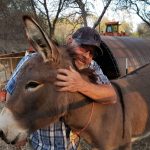Claire Bryan | (TNS) The Seattle Times
SEATTLE — When a student dies, it’s impossible not to wonder if there’s something that could have been done to save them. That’s true for every adult who shares the responsibility of keeping students safe. And it’s no different for people who have made a career out of teaching children the interpersonal skills they need to keep disagreements from becoming tragedies.
“Every time this happens, I feel like I haven’t done enough or we are too slow,” said Roger Kluck, the director of the Alternative to Violence Project. Kluck’s program provides a workshop where students do activities and play games to help build self-confidence, bond with each other and brainstorm how to solve problems and understand the underlying causes of violence.
There’s a lot that is still unknown about what led to the shooting death of a student at Garfield High School in Seattle on June 6. But indications are that Amarr Murphy-Paine was trying to prevent violence when he was killed.
At lunchtime that day, Murphy-Paine tried to break up “an altercation” between two boys. Then Murphy-Paine was shot and fell to the ground. The 17-year-old was transferred to the hospital where he was taken into surgery and later died.
In the aftermath of Murphy-Paine’s death, the Garfield community is searching for steps to take to avoid future violence. This includes school safety measures and more community support. Schools, including those in Seattle, also continue to invest in violence prevention efforts.
Kluck and other experts said prevention can make a difference for students as they learn to deal with the big emotions that can lead to violence. Ideally, lessons should begin at the start of a student’s education and not as a stopgap measure once students are already in high school or after a tragedy has occurred.
“They are grieving and reeling and thinking proactive is kind of off the table,” Kluck said of students and teachers immediately after the loss of a student to gun violence.
The nearby Highline School District, 15 miles south of Seattle, invested $72,000 in one of Kluck’s multiday anti-violence workshops this fall.
“It’s an investment in helping to keep the campus safe,” Catherine Carbone Rogers, a spokesperson for the district, told The Seattle Times in September. “Other school districts have tried things like metal detectors and increased security guards and external factors. The philosophy here is really addressing safety from the inside out.”
Citing graduation planning and the recent events at Garfield, a spokesperson for Seattle Public Schools was not available to comment on exactly which violence programs are offered at district schools. But Seattle students do get some instruction aimed at teaching conflict resolution skills and social-emotional regulation. The district offers its own programming and several area nonprofits contract with individual schools.
And the city has committed up to $10 million aimed at youth mental health and safety for the coming school year, according to a Friday announcement by the mayor’s office. An initial $2.4 million will go to providing increased access to telehealth therapy services for students, starting this summer.
AVP facilitator June Thomasson tapes up a poster that reads “using transforming power” during an anti-violence workshop during the first week Evergreen High School on Sept. 7, 2023. (Daniel Kim/The Seattle Times/TNS)
Social-emotional learning programs that teach self-regulation, problem-solving and communication skills are crucial as early as preschool and throughout elementary school, said Tia Kim, a developmental psychologist and a vice president at Committee for Children, a Seattle-based nonprofit that works in over 45,000 K-12 schools in the country. Research shows these skills foster emotional safety, which in turn helps reduce violence.
By the time students are in high school, this type of programming has to be served up to them differently, said Kim, whose organization works with some Seattle schools. (It does not serve Garfield High School.) When kids are younger, there can be direct lessons about these skills, but the older they get, the more educators need to integrate these skills into academic lessons, assemblies or games, Kim said.
For example, math teachers learn how to help students have a growth mindset about what they are learning while also teaching them how to cool off and regulate their emotions if they get frustrated by a problem and feel empowered to ask for help when they need it.
Educators should also work to develop strong relationships with students and promote a positive school climate to keep students invested in school and away from problematic behavior, Kim said. Involvement in sports, activities and academics also helps keep kids safe.
“High academic performance is typically a really good protective factor to youth violence,” Kim said.
There is not one factor that will always protect children from violence, though. Experts recommend focusing on teaching kids the skills they need to resolve conflicts on their own such as self-regulation, active listening, clear communication, not placing blame and empathy.
“These are skills that help people deal with things for the rest of their lives,” said Dave Martine, the executive director of the Dispute Resolution Center of King County, a nonprofit organization that offers affordable mediation and conflict resolution services to schools and businesses.
Martine has advocated to the state Legislature for funding for peer mediation programming in every school in King County. That didn’t happen. But the state has made some efforts to improve students’ emotional health. In 2019, the Legislature required that one state-funded professional development day for educators be focused on social-emotional learning every other year beginning in 2021.
The Office of State Public Instruction has provided webinars and online modules for teachers that include trauma-informed practices, which are ways of interacting productively with students dealing with the fallout from domestic violence, neglectful caretakers and drug use at home and in their communities. State education officials have also provided multiple webinars and meetings as well as coaching on how to offer classes in social-emotional learning, create a positive school climate and improve educator and student well-being, among others.
Right now, it is hard to reach the Seattle Public Schools staff most focused on conflict resolution in schools.
The district has a restorative justice program, which seeks to help students and staff resolve differences by listening to the other person’s side of the story, admitting when you’ve hurt someone and making amends. The district program also provided staff training on conflict resolution. And it partners with a variety of community organizations to host programming like healing circles.
Lian Caspi, the restorative program manager, wasn’t available to comment on that program last week. She had an away message on her email that said she was out supporting Garfield students and would be slow to respond.
It’s hard to know what to do for a community after a tragedy like a shooting because each one is different and every violent situation is different, said Martine, who runs the Dispute Resolution Center. Organizing circles where people can speak to one another in a safe place to share their point of view with no threat of rebuttal is one thing that can help, Martine said.
Kim, the developmental psychologist, agrees that letting people talk about what happened to them and how it felt is key.
“Being able to do that helps [students] process through it and feel validated for feeling a particular way,” Kim said. Routine and a sense of normalcy are also crucial, Kim said. “Consistency really helps kids feel safe and secure and really grounded. They know what to expect.”
___
©2024 The Seattle Times. Visit seattletimes.com. Distributed by Tribune Content Agency, LLC.


